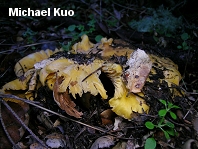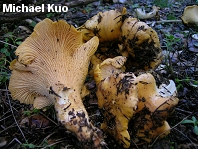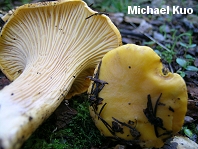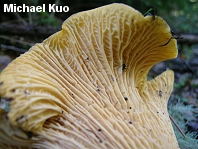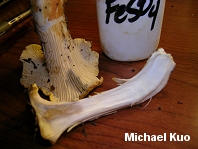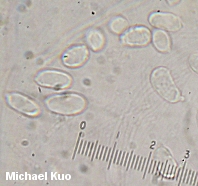| Major Groups > Chanterelles and Trumpets > Cantharellus species: "Mud Puppy" |

|
Cantharellus species 01: The "Mud Puppy" [ Basidiomycetes > Cantharellales > Cantharellus . . . ] by Michael Kuo NOTE: This page is outdated as of February, 2009, and has been replaced by a page for Cantharellus californicus. The material here is preserved to accommodate bookmarks and to document the previous publication. Chanterelle collectors in the San Francisco Bay area are familiar with a large chanterelle that appears in fall and winter under live oak, especially after heavy rains. It is a messy, bright egg-yolk yellow mushroom that pushes up through muddy debris, often creating "mushrumps" on the forest floor. It lacks the gracefully tapered stem, tiny scales, and pinkish hues in the false gills of Cantharellus formosus, and currently passes as "Cantharellus cibarius." Local collectors call this chanterelle the "Mud Puppy," and do not rate it highly as an edible, despite its large size. It is usually soggy, and lacks the firm texture and subtle, fruity taste that chanterelle lovers are familiar with (I have tried a few bites, and I have to agree). Given its fairly distinctive ecology, I think the Mud Puppy is worth holding up as a putative "species" of Cantharellus. It is certainly different from other chanterelles I have collected in North America and Europe, though my experience with morels makes it clear that differences in physical appearance do not necessarily correlate to actual genetic differences. My description of the "Mud Puppy" is below, followed by comments on possible other published descriptions and analyses of the mushroom. Description: Ecology: Apparently mycorrhizal with California live oak (Quercus agrifolia); growing alone, scattered or gregariously in winter (also fall, according to local collectors); often pushing up through mud and forest debris after heavy rains and remaining partially covered; northern California. Cap: To 20 cm across; at first planoconvex with an inrolled margin, becoming broadly convex, flat, or shallowly depressed with an inrolled, uplifted, or irregular-wavy margin; the center not becoming perforated; smooth; egg-yolk yellow, with scattered areas of a whitish, filmy coating; sticky to nearly slimy when fresh. Undersurface: With well developed false gills that run down the stem; colored like the cap or paler; by maturity with frequent cross-veins. Stem: To 10 cm long and 3 cm thick; fairly stocky; equal; more or less smooth; pale yellow; discoloring and bruising brownish, especially near the base; fleshy. Flesh: Whitish; thick; stringy; water-logged when wet; not changing color when sliced and exposed to air. Chemical Reactions: Flesh and false gills grayish with iron salts. See Reactions to Iron Salts among the Chanterelles. Odor and Taste: Taste mild; odor fragrant and sweet. Spore Print: Not recorded (oops). Microscopic Features: Spores 9-11.5 x 3-5 µ; smooth; more or less elliptical; with an apiculus about 1 µ long. Basidia 2- to 6-spored; to 130 µ long. REFERENCES: The description represents Herb. Kuo 01120606 (January 12, 2006, San Mateo County, CA). Dunham et al. (2003) included one specimen, which they numbered "76057," from Santa Barbara (in southern California) in a DNA study of chanterelles that led to the naming of Cantharellus cascadensis (from Douglas-fir and western hemlock forests in Oregon) and included collections of the Pacific Golden Chanterelle (Cantharellus formosus), the "true" Cantharellus cibarius from Sweden, and Cantharellus cibarius var. roseocanus (a variety recorded from the Pacific Northwest with a yellowish pink, hoary covering on the fresh cap). "76057" was collected under "oak," and its DNA indicated a clear separation (as measured with RFLP technology) from the other chanterelles in the study. The authors suspect that 76057 "may represent the variety C. cibarius var. pallidifolius described from Michigan by Smith (1968) and described by Thiers (1985) as mycorrhizally associated with tanbark oak (Lithocarpus densiflora) in California" (1174), but they were unable to compare DNA since Smith's type collection of Cantharellus cibarius var. pallidifolius had degraded too far for DNA extraction. Cantharellus cibarius var. pallidifolius is described by both Smith and Thiers as differing on its paler false gills and pinker spore print. The 1960 Smith collection from Michigan is apparently too old for DNA comparison; the Thiers collection from California is not documented (it was apparently made in Mendocino County under tanoak, prior to 1985, and was identified as a match to Smith's Michigan collection on the basis of physical features). Smith's collection was made in Emmet County, Michigan, near the town of Pellston, on August 23, 1960 (type cantharellus in the "Genus" box of this page at the University of Michigan's Fungus Herbarium, then scroll through the results to find Cantharellus cibarius var. pallidifolius). I have seen thousands of chanterelles in Emmet County, many of them near Pellston, for over 15 years--and I think the Bay Area's "Mud Puppy" seems pretty clearly distinct from anything I've found in Michigan. Further Online Information: "Cantharellus cibarius" as described at MykoWeb appears to match the mushroom I am describing here. Michael Wood and Fred Stevens describe a chanterelle that grows under California live oak and tanoak in the Bay Area, and most of the photos provided (see "Other Descriptions and Photos" near the bottom of the page) show a chanterelle meeting the description above, with clearly identifiable live oak and tanoak leaves present. This photo demonstrates the whitish film that appears on some caps. |
© MushroomExpert.Com |
|
Cite this page as: Kuo, M. (2007, August). Cantharellus species 01: The "Mud Puppy." Retrieved from the MushroomExpert.Com Web site: http://www.mushroomexpert.com/cantharellus_sp_01.html |
